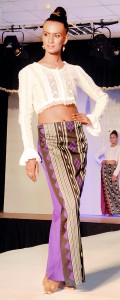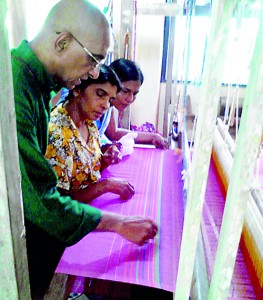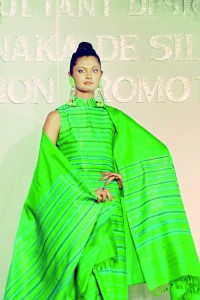Lanka’s handlooms to weave a storm
Much sought after are their ‘products’, with people coming in search of their centre a few months after a life-changer which has lifted them from being mundane weavers to those who have a “good” eye for colour and design.
Their products are wide and varied, an explosion of colour in all its beauty — stunning sarees, ranging from plain to those with intricate designs, salwar kameez, sarongs with shirts to match and beachwear.
Into the spotlight has also been brought the kaba-kuruththuwa, the traditional blouse Galle is famous for, having been introduced by the Dutch, but now gone out of vogue.
Eleven humble women, eking out a living through weaving at the Kahawa Ruhunu Ransalu Nimavum Hala, empowered and now able to think out of the box.
Whether wrapping yarn, fixing the ‘warp’ (the threads that run the length of a fabric that is being woven) or attending to the ‘weft’ (the threads that run across the width of the fabric) or sitting at the loom, these women’s lives have changed forever.
Their sights are now set on the international markets, with their vision widening not only to do the basics but also to think of additions and accessories.
A black business suit with a stunning shawl; a quilted suit with a red shawl, sarees with flower-decorated pallus, the list goes on.
The turning-point came after a 10-day workshop for about 30 including women from the Kahawa centre as well as ‘Master Weavers’ all of whom are women in the south, from September 18-27, last year (2013).

Teaching: Crafts and textile designer Senaka de Silva at the Galle Centre
It was not just a workshop, but a thread that remained unbroken, for hot on its heels came the chance for these women to bring into the spotlight their works through a Fashion Show on December 3, last year, at the Halle de Galle.
The stuff is very beautiful, Akuressage Lilanthi Renuka who was in charge of the centre at the time of the Fashion Show is quick to point out, adding that you can’t say they are even handlooms.
It was creativity teamwork, says Lilanthi who is now heading the newly-established Design Centre at Maha Modera in Galle. All these projects come under the mandate of the Industrial Development Ministry of the Southern Provincial Council.
The catalyst for both the workshop and fashion show was none other than well-known crafts and textile designer Senaka de Silva, who has been taking time off his busy schedule to do what he loves, teach.
Not only has he been imparting his expertise to the women of the south but over the years to different groups across Sri Lanka including some Muslim men-weavers of Maradamunai.
For most weavers, this is a cottage industry and they are stuck in traditional moulds. Initially, it is difficult to penetrate their minds, as they are wary but when he goes to them with “karadasi thiru” (strips of paper) to get a sense of colour, it catches on, he says.
The weaver is paid by the metre and in most cases there has been no design guidance, according to Senaka.
“Weaving is a visual experience,” he points out, and there is a double benefit for the weaver. While learning to experiment with colours,  if they have better designs on their products, they would get a better price.
if they have better designs on their products, they would get a better price.
This is why he has been going around the country empowering them and teaching them “how to move colour”. Colour has always fascinated Senaka whose creativity took off as a child at the Melbourne Art Classes of Cora Abraham.
The stimulation came from the fact that they were made “unafraid” of colours. “We could use any colour with anything, without thinking of matching. There was absolute freedom. This opened our eyes, for we had ‘freedom of expression in colour’,” recalls Senaka who was also deeply interested in textiles and enthralled when he saw beautiful sarees and exotic jewellery.
Later at the Department of Aesthetic Studies although he went in the line of fine arts and majored in ceramics, the love of his life remained textiles. The rest, of course, is history…….while an undergraduate doing a little part time work at Vipula Dharmawardena famous for batiks, where too he had total freedom; being part of Orientations, a company that exported batiks during the era of Prime Minister Sirima Bandaranaike, being the in-house designer for Laksala; working with Barbara Sansoni; and giving his expertise to the National Crafts Council by travelling across the country to remote villages to pass on his knowledge of crafts and textiles.
He recalls how about a decade ago working with the Textile Ministry, he introduced vibrant colours to the National Exhibition.
His idea to raise the fabrics being exhibited from the mundane to the exotic had been very simple – assign he did different colours to the different areas. The south got the colour of the sea; Uva the colours of tea estates and waterfalls; Wayamaba the monastic colour of yellow; Ratnapura the colour of gems; Kandy the colour of dancers’ attire; and Colombo, the colour of city lights to indicate diversity.
Getting back to bare threads, Senaka explains how he makes weavers see two colour-combinations, how certain colours work and certain colours don’t, coming up with a colour blanket. “I see what works and base my designs on that.”
He also guides them on the little things that matter – handbags and jewellery to match the clothes, with his last collection showcasing jewellery made of yarn.
He turns the focus onto the kaba kuruththuwa made of woven cloth with lace inserts which he teamed with the cloth and which went on the ramp as the December Fashion Show opened.
With the dawn of the New Year, Senaka hopes to take these handlooms to the international market.
While planning a ‘Handloom Collection 2014’, his dream is to open a crafts and handloom village in Kalpitiya to give the people of this impoverished area a better livelihood.
He is sure that with a little bit of value addition, Sri Lanka’s handlooms can take the world by storm and is working towards becoming that ‘essential link’, between the weavers and the fashion world out there.


